Above, the highest specification 2016 Apple MacBook Pro (Space Grey) sold by Apple, featuring an Intel Core i7 6920HQ processor, 16GB of Ram, and a 2TB PCIe Solid State drive. It also features upgraded AMD Radeon Pro 460 discrete graphics.
At £4049, its certainly quite the investment. I know KitGuru has a very PC centric audience, but I really do rate Apple build quality very highly, especially their laptops.
The first course of action is to install the Drobo Dashboard software from the Drobo website.
When the Drobo 5D3 is connected to the Apple MacBook Pro and the software is loaded the above image can be seen. This shows that the Drobo 5D3 is connected but not yet ready to use. Double click on the product image in the middle.
The software immediately detected a firmware upgrade which was quickly downloaded and installed. The 5D3 then rebooted.
The Drobo 5D3 was then showing a green icon meaning it was ready to use.
You can now name the partition but I just left it with ‘Drobo'.
Checking the capacity panel shows the breakdown of the 5 x 4TB drives we installed. 20TB is shown with 18.19TB ‘actual' with basically one drive used for ‘protection' @ 3.8TB. 14.35TB is available for DATA storage.
The Drobo dashboard then requested a format of the 5 drives installed. I agreed and within a couple of minutes the software sent an alert to say the process was complete. A maximum partition size of 64TB is possible if you have big enough drives!
The General settings panel: While Drobo default the protection system to a single drive, if the data you are storing is extremely important then you can set it for Dual Disk Redundancy for added peace of mind. You can also DIM the lights here on a scale of 1-10.
Dashboard Preferences: This panel offers additional support for discovery (if you have a NAS device on your network). There is an automatic update setting as well which you should just leave enabled to ensure you are running the latest software from the company.
There are options here to change the visual alert system and you can even have the system email you alerts. The Bar Menu system defaults to ‘on' but you can turn if off, if you don't want the icon showing in your taskbar. I left it on however as its useful being able to load the software with a simple click from the finder.
As a final note, you can see an icon bottom left underneath the image of the product itself – this shows that the mSATA ‘hot data cache' is active. If you don't install an mSATA drive then this will not show.
You can also set up a Time Machine volume by creating a volume and following the wizard. I personally prefer to use Carbon Copy Cloner but you can see by the images above just how straightforward this is.
The final page entitled ‘help and support' gives quick easy access to Register your Drobo device, alongside viewing user guides, searching the knowledge base and contacting Drobo support directly. There is also an option here to create a diagnostics file to send to Drobo, if necessary. As the image shows we are using the latest V 3.1.1. (91377) of Drobo Dashboard.
Interestingly when the device appeared in Mac OS -we saw a partition size of 70.37 TB. We asked Drobo about this and their reply was:
“This is part of the thin provisioning as one of the added values of Drobo is to add more storage later without the need for reformatting.
The max volume supported is the amount you see in the OS which also shows you that it is not just ready for the common HDDs of today (the 4TB that you are using) but it is also ready for the “soon to become common” HDDs of tomorrow (10+ TB).
As you noted though, it does show it correctly in Drobo Dashboard and it also shows it correctly on the Drobo itself.”
Personally I think I would rather get the actual partition size showing in Mac OS, rather than a potential configuration I could have if I used the biggest possible drives on the market.
Also for those wondering the differences between the 64TB maximum size registered in Drobo Dashboard and the 70.37TB showing in Mac OS, this is because Drobo measures in Terabyte and Mac OS in Tebibytes.
64TB = 70,3687 TiB – so this is the same.
 KitGuru KitGuru.net – Tech News | Hardware News | Hardware Reviews | IOS | Mobile | Gaming | Graphics Cards
KitGuru KitGuru.net – Tech News | Hardware News | Hardware Reviews | IOS | Mobile | Gaming | Graphics Cards


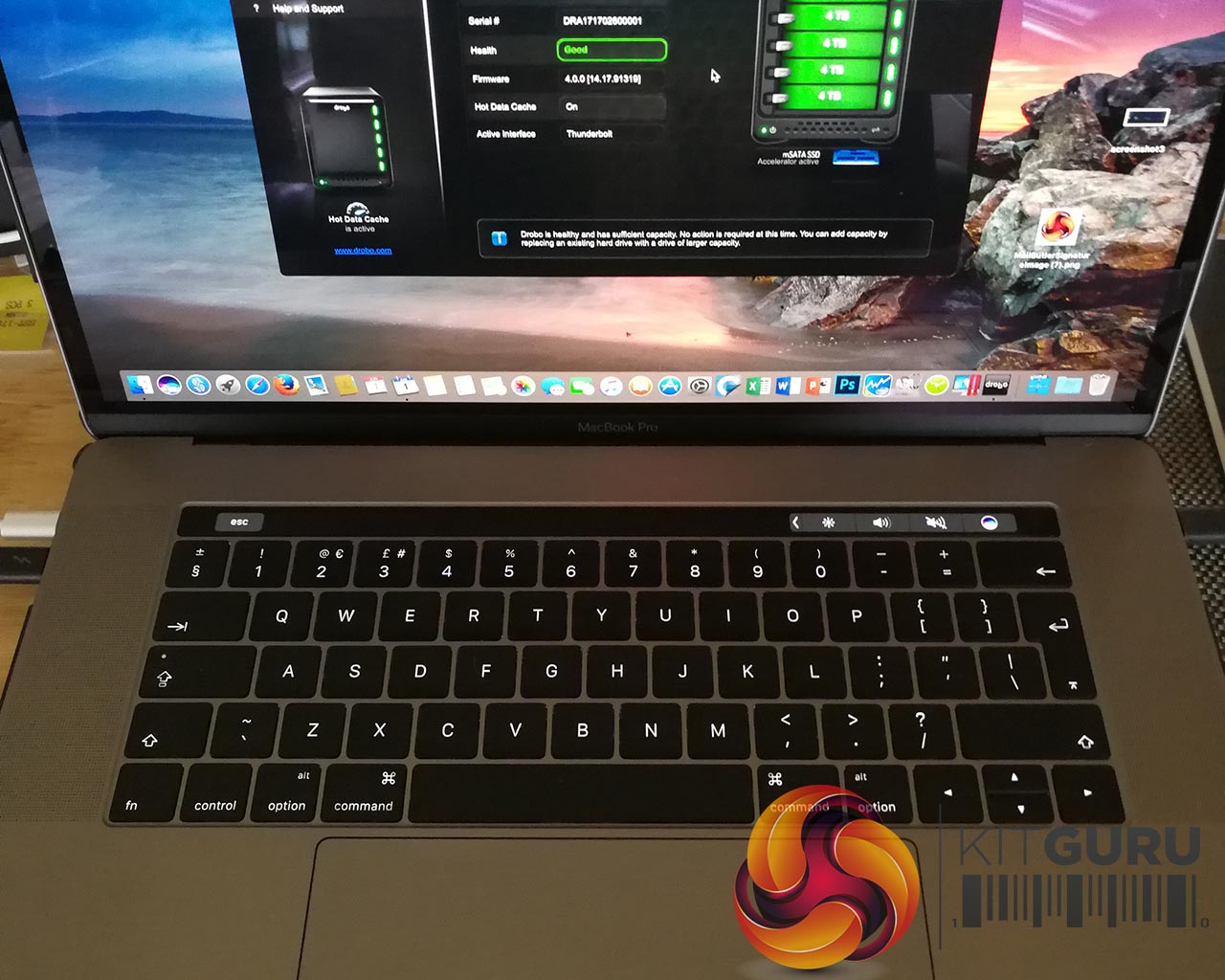
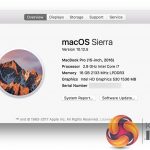
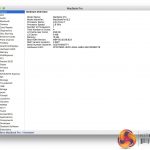
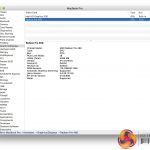
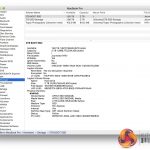
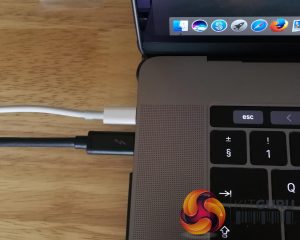
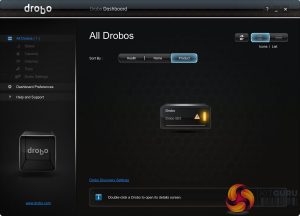
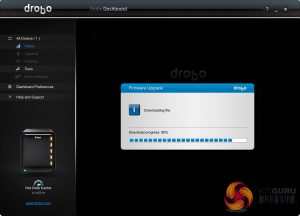
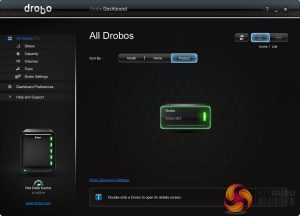
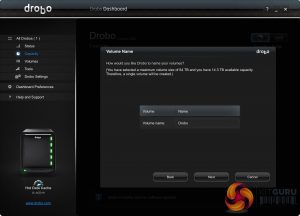
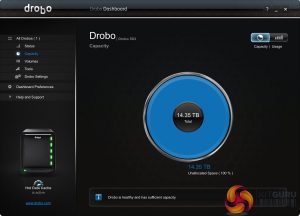
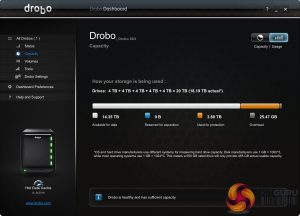
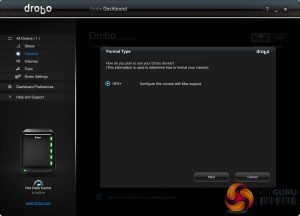
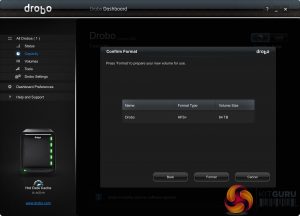
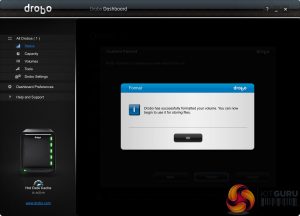
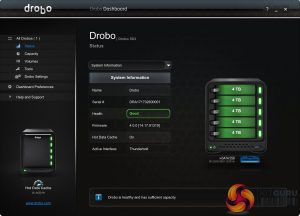
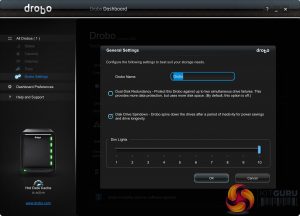
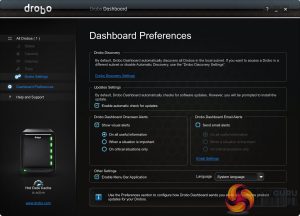
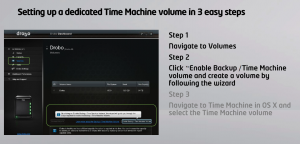
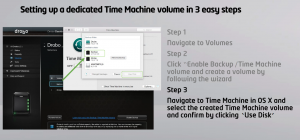
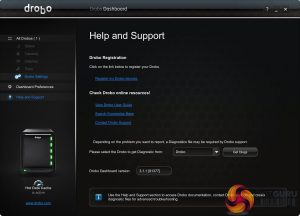
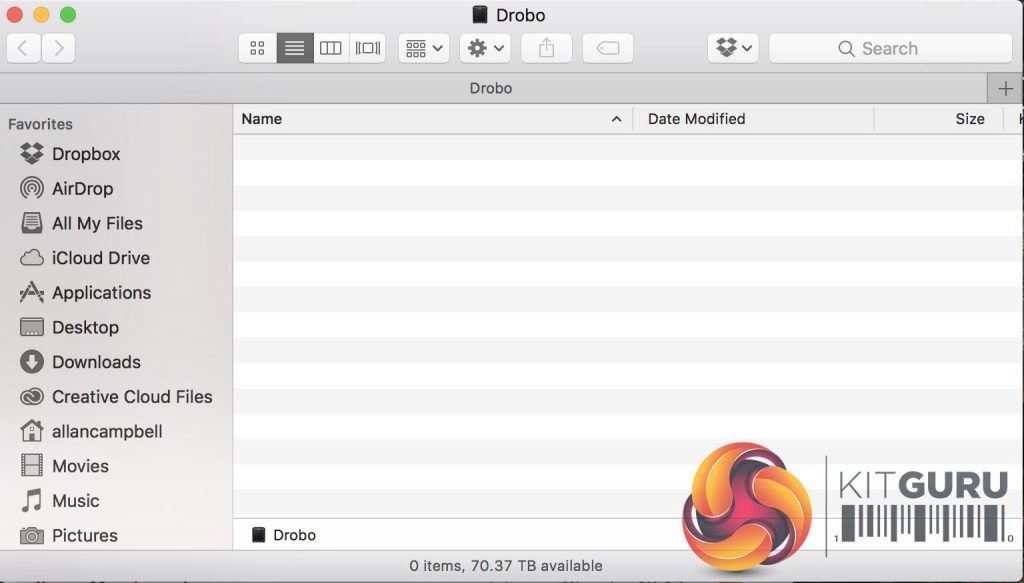

When you say “cooling system is quiet in operation” are you referring to the noise from the unit overall? How quiet is quiet BTW? If I got one of these I would use it in a cabinet in my living room with the rest of my AV gear – BluRay, Tivo, Mac Mini server etc.
Also, how do you feel about the proprietary RAID method used by Drobo? In the past there have been a number of issues and a lot of angry people who have lost data. Their RAID method is now 3 or 4 generations in so I expect that it is fully “debugged.” Do you agree?
There seems to be a lot of inconsistencies in user experience out there with Drobo. On paper it is by far the best solution, but a lot of strongly negative reviews has given me pause. Has Kitguru been using the device continuously and do you still feel this is a strong buy?
In the direct attached storage market.. You’ve got drobo.. you’ve got promise.. and custom enclosures via usb 3.1. (I use all of them)
Promise tech. Pegasus you get super high performance.. but its a standard RAID. so all the drives have to be the same make and model
.. With drobos you lose a little bit of performance but gain flexibility and ease of use.
Custom enclosures you can build it exactly the way you want.. but you will only get usb 3.1 speed.
With drobo or promise, pay for the warranty and the support. Drobo support is very good as long as you keep it up to date and pay for it.
I use them all.. but at home with my photography business, i use drobo. i’ve been using drobo products since their 1st gen 10+ yrs ago. Now i’m using a Drobo 5D. Its been chugging a long for 3 yrs now, no issues other than an occasional bad drive. Its my primary storage.. but its NOT my only storage. I have a onsite and offsite backup too.
Any system can and WILL fail.. you cant just depend on one. Drobo is a great choice as long as you keep the warranty up. Their support has always been very helpful.
The 5d3 is listed with two model numbers DRDR6A21 & DRDR6A31. Any idea what the difference is? The later seems to be the only type available in the UK. I just want to make sure one isn’t configured more for Mac OS, as I’m only on windows. Thanks
the fans are quiet, you get some occasional drive noise.. but you will with any drive.. in a cabnet you’d never know it was there..
The people complaining had no other copy of their data.. any drive system can fail.. these systems are redundant..thats just reckless..
I’ve been running various drobo products for 10 yrs now. I have had better luck with drobo das systems than with promise, g-tech, or lecie
If you use it as recommended, put recommended drives in it.. AND have a backup of some kind, you’ll be fine.
I bought a Drobo 5D3 last week along with 5 Samsung 850 EVO SSD drives. Huge mistake to try Drobo again. I can’t believe how slow it is compared to everything else. Why did they make a thunderbolt 3 version when the maximum speeds you can get are far, far below what thunderbolt 3 offers. The write speed for a 5 x SSD array is much slower than a single drive. Even the read speed for the 5 x SSD array is only 800 MB/s. When I put those same 5 drives in my other device, I get 3-5x better read and write speeds. There is just no excuse for that. If you need performance the Drobo 5D3 will make you sad. It’s not worth wasting a thunderbolt 3 port. https://uploads.disquscdn.com/images/38d7cc3218744efa8cf8ecded856a4eb9af8494ba84bd8eec0bce0889f779d43.png
James, did you figure out why that’s the case, as test show far better performance…
I didn’t see any test that used SSDs inside the Drobo, but my results are definitely faster (at least for reading) than anything I’ve seen posted anywhere.
Many people suggested maybe switching to an “active” thunderbolt 3 cable would improve things. I doubted it would, knowing that the current results were already below what you would expect even with a thunderbolt 2 cable. But I went ahead and spent $75 to get an “active” tb3 cable and re-ran my tests. Guess what? the results did not change at all. The best performance you can hope to get from the Drobo 5D3 is what I have posted above.
I have tested using HDDs, SDDs, USB3 cables, thunderbolt 3 passive and active cables, etc. It’s only slightly slower over USB3 than it is over thunderbolt, which tells you everything you need to know. USB3 is rated at 5 Gbps. Thunderbolt 1 at 10, Thunderbolt 2 at 20, Thunderbolt 3 at 40. But the Drobo doesn’t come close to using even Thunderbolt 2 speeds, so… yeah.
I have tested on my 2017 iMac with a 1GB SSD and 64 GB of RAM. It’s the fastest machine you can get from Apple today. The Thunderbolt 3 active cable is as fast as they come. The Drobo is anything but fast. It doesn’t even utilize enough bandwidth to saturate Thunderbolt 1. That’s just sad.
To say I’m disappointed is an extreme understatement.
James, thank you so much for your reply. For me it’s important, as I’m going to buy myself a new iMac (the full blown one, but not waiting for the pro as that will be overpriced I guess). I’m doing productivity apps and photo (LightRoom – RAW processing) and a bit of video. My intention is to have a 2Tb SDD as main drive, and a fast DAS attached to that as an extension of my main harddrive. (I’ve currently an iMac 2013 with 3 Tb fusion drive, and it’s completely full…). So I don’t intend to use the DAS just for backup purposes. Not eager to consider a NAS either for that, also because I’m using Backblaze as a kind of secondary way of backup, and as you know a DAS can be included in the Backblaze backup, NAS cannot. What alternative would you recommend? Thanks for your insights and advise!
That is my use case as well and precisely why I am so disappointed with the Drobo. I think the fastest DAS you can get right now is the Thunderbolt 3 QNAP stuff, but it’s a lot more expensive than the Drobo. I’m considering changing my workflow so all my “current” and unprocessed photos and Lightroom catalogs live on the internal SSD. As it is, there’s no reason to have the SSDs in the Drobo. The Drobo performs almost as well with fast HDDs… so then I ask myself what I’ll do with the 5 SSDs that I bought for this… and that’s why I may wind up shelling out the money for the QNAP and plugging them in there.
As of now I’m still using the Drobo for my primary storage for photos and Lightroom catalogs. In this configuration my new iMac performs slightly better than my 2013 iMac with the 3 TB fusion drive (sound familiar?). At some point it will upset me enough that I’ll make a change and either buy the QNAP or change my workflow, but so far I’ve just been too busy getting stuff done to deal with it. Hope that helps.
James, but that means if I’d use a QNAP, it’s NAS, so Backblaze won’t include that in their online backup, as they only include DAS, correct?
You can directly connect the QNAP via Thunderbolt 3 just like the Drobo, so it should be considered a DAS, but I can’t guarantee that Backblaze would treat it that way. I don’t use Backblaze, so I don’t know. Check out the QNAP TVS-882ST3-i7-16G-US and see what you think.
James, the QNAP is really very expensive. Think I’m better off buying a Samsung SSD 4TB and attach it over Thunderbolt, and buy a Drobo as the backup device… total cost will be lower, and speed (of the Samsung SSD 4TB higher than the QNAP, no?
James, any comment to what I posted 10 days ago…? Thanks.
I don’t know what Samsung SSD you’re talking about, but unless it involves multiple drives it won’t be as fast as the QNAP. A single SSD drive connected via USB 3.1 will provide almost the same performance as the Drobo, but not close to as fast as the internal SSD or the QNAP (thunderbolt 3).
If you want really fast Thunderbolt 3 external storage, I can recommend the Lacie Bolt 3. It is very expensive. And 3TB gets full quickly. I use it to dump images from my shoots for quick back-up and to keep space on the 1TB disk in my MacBook Pro available for new shoots.